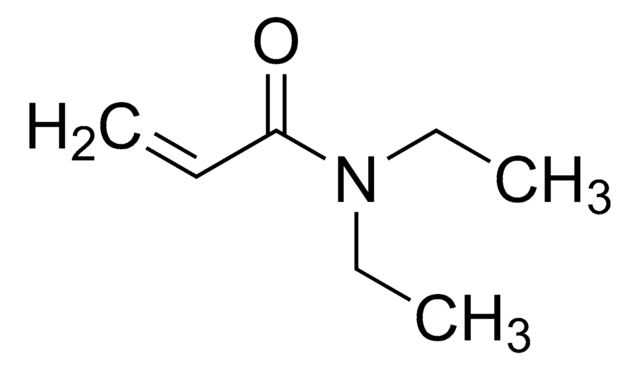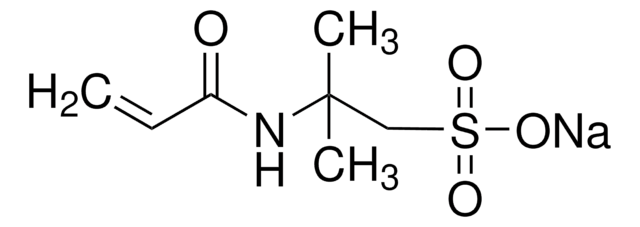448273
4-Acryloylmorpholine
97%, contains 1,000 ppm monomethyl ether hydroquinone as inhibitor
Synonyme(s) :
1-(Morpholin-4-yl)propenone, 1-Morpholinoprop-2-en-1-one, 4-(1-Oxo-2-propenyl)morpholine, 4-Acryloylmorpholine, Acryloylmorpholine
About This Item
Produits recommandés
Pureté
97%
Contient
1,000 ppm monomethyl ether hydroquinone as inhibitor
Indice de réfraction
n20/D 1.512 (lit.)
Pf
−35 °C (lit.)
Densité
1.122 g/mL at 25 °C (lit.)
Température de stockage
2-8°C
Chaîne SMILES
C=CC(=O)N1CCOCC1
InChI
1S/C7H11NO2/c1-2-7(9)8-3-5-10-6-4-8/h2H,1,3-6H2
Clé InChI
XLPJNCYCZORXHG-UHFFFAOYSA-N
Catégories apparentées
Description générale
Application
- To synthesize multiblock copolymers via RAFT polymerization. These functional block copolymers find application in the fields of medicine, energy, and nanotechnology.
- To prepare organogel electrode frame via photopolymerization and cross-linking. This can be used to fabricate triboelectric nanogenerators with excellent transparency, stretchability, and interface adhesion.
- For printing thermoplastic 3D tissue scaffolds. ACMO′s water solubility,and remarkably low viscosity, combined with surface oxygen inhibition, promoteswift liquid flow during high-speed open-air printing.
Mention d'avertissement
Danger
Mentions de danger
Conseils de prudence
Classification des risques
Acute Tox. 4 Oral - Eye Dam. 1 - Skin Sens. 1 - STOT RE 2 Oral
Code de la classe de stockage
10 - Combustible liquids
Classe de danger pour l'eau (WGK)
WGK 2
Point d'éclair (°F)
259.7 °F - closed cup
Point d'éclair (°C)
126.5 °C - closed cup
Équipement de protection individuelle
Eyeshields, Faceshields, Gloves, type ABEK (EN14387) respirator filter
Certificats d'analyse (COA)
Recherchez un Certificats d'analyse (COA) en saisissant le numéro de lot du produit. Les numéros de lot figurent sur l'étiquette du produit après les mots "Lot" ou "Batch".
Déjà en possession de ce produit ?
Retrouvez la documentation relative aux produits que vous avez récemment achetés dans la Bibliothèque de documents.
Les clients ont également consulté
Notre équipe de scientifiques dispose d'une expérience dans tous les secteurs de la recherche, notamment en sciences de la vie, science des matériaux, synthèse chimique, chromatographie, analyse et dans de nombreux autres domaines..
Contacter notre Service technique














![N-[Tris(hydroxymethyl)methyl]acrylamide contains ≤7% KCl, 93%](/deepweb/assets/sigmaaldrich/product/structures/130/961/5bc6d1a4-a540-4496-9f46-74507af67e21/640/5bc6d1a4-a540-4496-9f46-74507af67e21.png)
